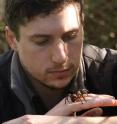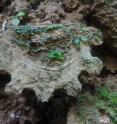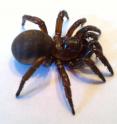What's hiding behind the trapdoor?
Australia is known as a country full of deadly creatures - now people have trapdoor spiders hiding in their backyards. The mysteriously elusive creatures are hiding in most forests in Brisbane and are tucked away in national parks throughout the state of Queensland, Australia.
PhD student Jeremy Wilson recently returned from a mission with the Queensland Museum to collect new specimens for its upcoming Wild State display, while also uncovering species of golden trapdoor spiders in common or remote parts of the state from Fraser Island to Cape York.
Mr Wilson has even found new spiders in Lamington National Park in the Gold Coast Hinterland, species that build intricate traps near Gympie and others around the Capricorn Caves in Rockhampton.
Because trapdoor spiders spend most of their life underground their true number and diversity has been a bit of a mystery.
Just four species of golden trapdoor spiders are known in southeast Queensland, but Mr Wilson says he's identified at least 10 more in that area alone.
"We believe there are many more undiscovered species out there," he says.
"The really cool thing about them is that they're really long lived and they don't move much, they live in these holes their entire life.
"What that means is it's really easy for populations to become isolated and become new species."
While some people's first instinct is to swat a spider away, Mr Wilson says these guys have an important role to play in the ecosystem.
The big female trapdoor spiders are likely to be the top invertebrate predator in their ecosystem.
Because populations are so dense, there can be a lot in a very small area which means whole populations could be wiped out by clearing a patch of forest.
"In Australia especially there is so much that is still unknown about them," Mr Wilson says.
"When they do conservation planning they need to know what's there. With only four species of so many potentially, these trapdoor species are in danger of going extinct before we even know they exist.
"The key thing to highlight is that predators are crucial to ecosystems as they control the population of all organisms at lower levels of the food chain."
Because they stay so well hidden, their danger is somewhat unknown but with 1cm fangs on some, there is potential to do serious damage.
Mr Wilson has become good at spotting the traps and handling the "aggressive" spiders.
"You have to be very careful with the spiders and if they're in a bad mood you don't pick them up. If you hesitate that's when it will bite you."
Mr Wilson wants to delve further into how the species and its trapdoors have evolved.
"If we know why evolution occurs and why different species occur then we can predict how things like climate change and deforestation could affect these spiders in the future.
"There's so much work that needs to be done and it's important work because these spiders get overlooked. They live in trapdoors and no one sees them."
Source: Griffith University
Other sources
- What's Hiding Behind the Trapdoor?from Newswise - Scinews8 years ago
- What's hiding behind the trapdoor?from Science Daily8 years ago
- What's hiding behind the trapdoor? Spiders, of coursefrom Physorg8 years ago




